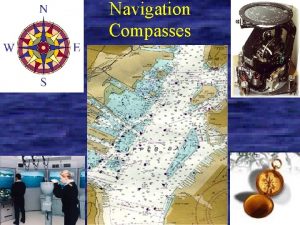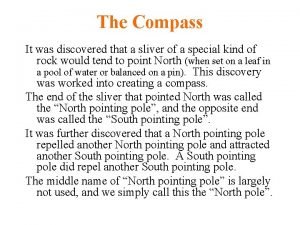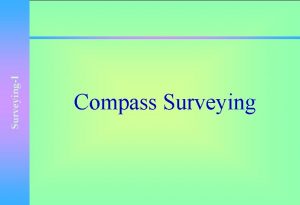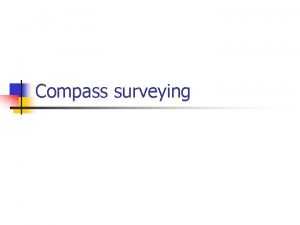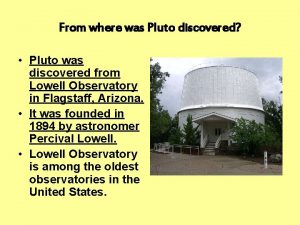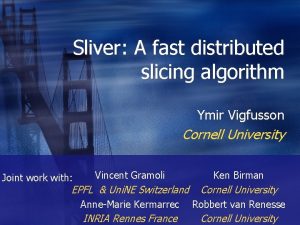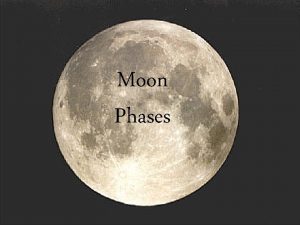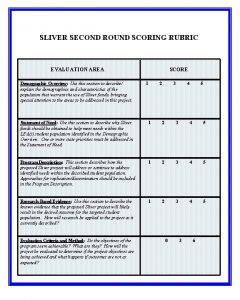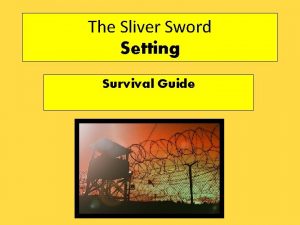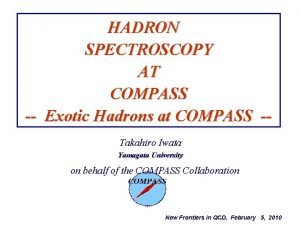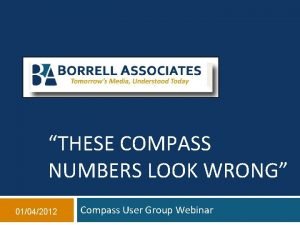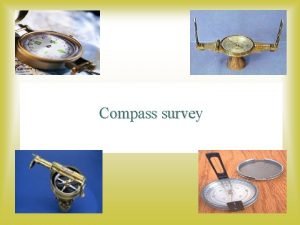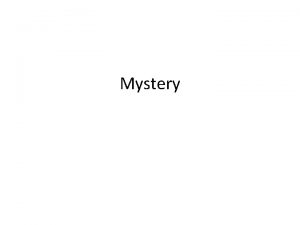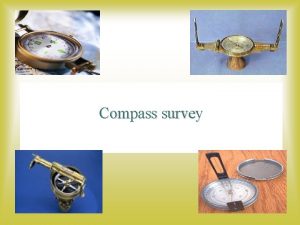The Compass It was discovered that a sliver




















































- Slides: 52

The Compass It was discovered that a sliver of a special kind of rock would tend to point North (when set on a leaf in a pool of water or balanced on a pin). This discovery was worked into creating a compass. The end of the sliver that pointed North was called the North pointing pole, and the opposite end was called the South pointing pole. It was further discovered that a North pointing pole repelled another North pointing pole and attracted another South pointing pole. A South pointing pole did repel another South pointing pole. The middle name of “North pointing pole” is largely not used, and we simply call this the “North pole”.

Magnetism We are probably all familiar with the facts that magnets (what we call that material used in the compass) repel and attract each other. This is similar to electric charges. This suggests that we can propose the following law (like Newton’s Law of Gravity and Coulomb’s Law for Electricity): Fmagnetic = X p 1 p 2 / r 122 where X would be the magnetic constant, analogous to G and k, that describes the strength of the magnetic force.

Magnetic Poles Fmagnetic = X p 1 p 2 / r 122 The “p” in the equation stands for poles. In magnetism, we have two kinds of poles, and we call them North and South. Like poles repel and unlike poles attract, just as electric charges do. However, unlike charges, we always have two poles! If we break a magnet (which has two poles) in half, we have not separated the two poles, rather we have two (smaller) magnets that both have two poles!

Magnetic Poles N N S S N S Break one bar magnet in half, and you have two smaller bar magnets!

Magnet in the Earth? If the magnet in the compass has its North pole pointing North, does that mean the Earth acts like it has a big magnet inside it? If so, that means that a South pointing pole (South magnetic pole) must be near the North rotational pole and a North magnetic pole must be near the South rotational pole. Weird – but to be consistent, that is what we have!

Magnetism Since we cannot seem to isolate one magnetic pole like we could electric charges, the force equation that is similar to Newton’s and Coulombs Law turns out to be not very useful. We do have a more useful alternative, though. It turns out that charges experience a force when moving near magnets!

Magnetic Force Just like charges set up an electric field, and other charges in the vicinity feel an electric force due to that electric field (Fel = q. E), we can work with the idea that magnets set up a magnetic field in space, and charges moving through that field experience a magnetic force. There are two things to note: 1. The charges must be moving. 2. The direction of the force is “weird”: the direction of the magnetic force is perpendicular to the velocity of the moving charge, and perpendicular to the magnetic field direction!

Notation for Directions Since the force is perpendicular to both the velocity and the field, we will almost always be dealing with 3 dimensions. We will use the following symbols for directions: North, East, South, West, same as regular map directions up or out head of arrow is sticking up (out of the page), down or in tail feathers of arrow with arrow sticking down into the page.

Magnetic Force Law magnitude: Fmagnetic = q v B sin(qv. B) This is often written as F = qv B where the indicates a vector cross product. direction: right hand rule: thumb = hand fingers Point your right hand in the direction of v, curl you fingers in the direction of B, and the force will be in the direction of your thumb; if the charge is negative, the force direction is opposite that of your thumb (or use you left hand).

Units Fmagnetic = q v B sin(qv. B) This law effectively defines the magnetic field, B (just like Felectric=q. E defined E). The MKS units of B are: Tesla = Nt-sec/Coul-m. 1 Coulomb moving at 1 m/s perpendicular (qv. B=90 o) to a magnetic field of strength 1 Telsa will experience a force of 1 Newton. A Tesla turns out to be a very large unit for magnetic field. We have a smaller unit that is often used: 10, 000 Gauss = 1 Tesla. A Telsa is sort of like a mile of magnetic field and a Gauss is sort of like a foot of magnetic field since 5, 280 ft = 1 mile.

Example A proton is moving at a speed of 3 x 104 m/s towards the West through a magnetic field of strength 500 Gauss directed South . What is the strength and direction of the magnetic force on the proton at this instant? qproton = +e = 1. 6 x 10 -19 Coul. v = 3 x 104 m/s, West B = 500 Gauss * 1 Tesla/10, 000 Gauss =. 05 T, South

Example, cont. magnitude: Fmagnetic = q v B sin(qv. B) direction: right hand rule magnitude: F = (1. 6 x 10 -19 Coul) * (3 x 104 m/s) * (. 05 T) * sin(90 o) = 2. 4 x 10 -16 Nt. direction: thumb = hand x fingers = West South = UP . Note: although the force looks small, consider the acceleration: a = F/m = 2. 4 x 10 -16 Nt / 1. 67 x 10 -27 kg = 1. 44 x 1011 m/s 2.

Magnetic Forces We’ll play with magnetic forces on moving charges in the Magnetic Deflection experiment in lab. At that time we’ll also discuss and experiment with the earth’s magnetic field. Computer Homework Volume 4 #1 is on Magnetic Forces and the Right Hand Rule.

Magnetic Force and Motion Since the magnetic field is perpendicular to the velocity, and if the magnetic force is the only force acting on a moving charge, the force will cause the charge to go in a circle: (remember that a sideways force will change the direction of the velocity, or in other words turn the particle; a circle is specified by its radius, r) SF = ma, Fmag = q v B, and acirc = w 2 r = v 2/r gives: qv. B = mv 2/r, or r = mv/q. B.

Mass Spectrograph We can design an instrument in which we can control the magnetic field, B. If we ionize (almost always singly) the material, we know the charge, q = e. We can use known voltages to get a known speed for the ions, v. We can then have the beam circle in the field and hit a target, and from that we can measure the radius, r. Hence, we can then calculate the mass using r = mv/q. B , actually using m = q. Br/v.

Example To see if this is really feasible, let’s try using realistic numbers to see what the radius of orbit for a proton should be: q = 1. 6 x 10 -19 Coul; B =. 05 Teslas (500 G) m = 1. 67 x 10 -27 kg; Vacc = 500 volts gives: (1/2)mv 2 = q. V, or v = [2 q. V/m]1/2 = 3. 1 x 105 m/s r = mv/q. B = (1. 67 x 10 -27 kg)*(3. 1 x 105 m/s) / (1. 6 x 10 -19 Coul)*(0. 05 T) =. 065 m = 6. 5 cm.

Mass Spectrometer Heavier masses will give bigger radii, but we can shrink the radii if they become too big by using bigger magnetic fields. Note that by measuring quantities that we can easily measure (charge, radius, voltage, magnetic field), we can determine very tiny masses! In one of our experiments in lab (Charge to Mass of the Electron), we will essentially determine the mass of an electron!

Other uses A cyclotron is an instrument used to accelerate charged particles to very high speeds. It uses magnetic fields to bend the charges around in circles to keep them in one place while they’re being accelerated. Magnetic bottles can be used to contain high energy plasmas in fusion research.

Magnetic Forces The Computer Homework Vol. 4 #2, Magnetic Deflection, deals with magnetic forces on charged particles. We’ll discuss strategies for completing this assignment in class.

Creating Magnetic Fields Gravitational fields acted on masses, and masses set up gravitational fields: Fgravity = mg where g = GM/r 2 Electric fields acted on charges, and charges set up electric fields: Felectric = q. E where E = k. Q/r 2 Magnetic fields acted on moving charges; do moving charges set up magnetic fields?

Creating Magnetic Fields Magnetic fields acted on moving charges; do moving charges set up magnetic fields? YES! From the gravitational and electric cases, we can guess that we will need: 1. a constant that describes the strength similar to G and k; 2. an inverse square relationship with distance (1/r 2); and 3. a dependence on what is acted upon (like m and q) - in this case, qv.

Creating Magnetic Fields But we also have the right hand rule in the magnetic force equation, and we’ll need a right hand rule in the field generating equation also.

Magnetic Fields B = ( o/4 ) q v sin(qvr) / r 2 direction: right hand rule thumb = hand fingers Point your hand in the direction of v, curl you fingers in the direction of r, and the field will be in the direction of your thumb; if the charge is negative, the field direction is opposite that of your thumb.

Magnetic Constant The constant ( o/4 ) is a seemingly strange way of writing a constant that serves the same purpose as G and k, but that is exactly what it does. The value: ( o/4 ) = 1 x 10 -7 T*m*sec/Coul (or 1 x 10 -7 T*m/Amp). In fact, the constant k is sometimes written as: k = 1/(4 eo). [In both cases, the sub zero on m and e indicates the field is in vacuum. ]

Creating Magnetic Fields B = ( o/4 ) q v sin(qvr) / r 2 r q vr v B field point Point your right hand to the right, bend your fingers up toward the top of the page, and your thumb points out of the page q vr v r Point your right hand to the right, bend your fingers down towards the bottom of the page, and your thumb points into the page field point B

Creating Magnetic Fields A single moving charge does create a magnetic field in the space around it, but since both the charge and the constant are very small, we usually don’t have to worry about these effects - except in three cases: 1. magnetic materials (permanent magnets), 2. currents (electromagnets), & 3. inside the atom (chemistry energy levels).

Creating Magnetic Fields: 1. Permanent Magnets Materials are made up of atoms that have electrons moving around the central nucleus (more on this in part 4). These moving electrons create magnetic fields. However, in almost all materials the magnetic fields created by the orbiting electrons tend to cancel - except in some materials like iron. This is the basis of making magnets out of iron bars.

Creating Magnetic Fields 2. Electromagnets If we have a series of charges moving (which means a current), then we can generate an appreciable magnetic field. A moving charge (qv) actually can be thought of as a current over a small length: qv = q(DL/Dt) = I L so that we have for each small length: B = ( o/4 ) I L sin(q. Ir) / r 2 with direction: thumb(field) = hand(current) fingers(radius).

Special Cases For the current over a complete circuit, the magnetic field produced at any particular point in space will depend on where the point is and the shape of the circuit.

Loop of Current B = ( o/4 ) I L sin(q. Ir) / r 2 For the magnetic field at the center of a current loop we have the special equation: each of the ΔL’s adds a small ΔB of equal magnitude in the same direction and all with q. Ir=90 o, so added together the ΔL’s = 2 R , and B = (mo/4 p) I 2 R sin(90 o) / R 2 which gives: Bat center of loop = o N I / 2 R where N is the number of turns in the wire since each turn creates a magnetic field, I is the current in each loop, and R is the radius of the loop. ΔL R I

Example What is the field strength at the center of a loop that has 0. 2 Amps running through 3400 turns, where the radius of the loop is 6 cm? Bat center of loop = o N I / 2 R B = (4 p x 10 -7 T*m/A) * 3400 * 0. 2 A / (2*. 06 m) =. 0071 T = 71 Gauss. (As you move away from this center, the field will decrease. )

Review Basic equation for calculating magnetic fields at points in space: B = ( o/4 ) I L sin(q. Ir) / r 2 with direction: thumb(field) = hand(current) fingers(radius) (where the I L is interchangeable with qv).

Review - continued Basic equation for calculating magnetic fields: B = ( o/4 ) I L sin(q. Ir) / r 2 with direction: thumb(field) = hand(current) fingers(radius). • Bat center of loop = o N I / 2 R • Bhelmholtz coil = 8 o. NI/[125]1/2 R • Blong straight wire = o I / 2 a UNITS: Note all equations for B should have a o, an I, and a (1/distance).

Forces, Fields and Currents If currents can create magnetic fields (as we just saw), then currents should be acted upon by fields. Another way of saying the same thing is: fields act on moving charges [F = qv. B sin(qv. B)], and currents consist of moving charges [qv = I L] , so we have:

Magnetic Force on Current Fon current = I L B sin(q. IB) with direction: thumb(force) = hand(current) fingers(field). Let’s now consider how this force will work on complete current circuits, not just individual lengths.

Forces on rectangular current loop Consider the situation in the figure below: A current loop (with current direction going counter-clockwise) is situated in a Magnetic Field going from North to South poles. N B pole S pole I

Forces on rectangular current loop We need to consider the forces on each of the four sides of the current loop. The force on the top and bottom of the loop are zero, since the field and current are either parallel or anti-parallel ( IB = 0 o or 180 o). I Ftop=0 N B pole S pole I Fbottom=0

Forces on rectangular current loop The current on the left side is going down while the field is directed to the right, so that means the force is directed out of the screen, and the magnitude is: Fleft = I L B sin(90 o) = I L B. N F I B L S

Forces on rectangular current loop The current on the right side is going up while the field is directed to the right, so that means the force is directed into the screen, and the magnitude is: Fright = I L B sin(90 o) = I L B. N B F I S L

Net Force Ftop = 0 Fbottom = 0 Fleft = ILB out Fright = ILB in As we can see, the NET FORCE (S F) is zero. However, since the force is pushing out on the left and in on the right, there is a Torque! The loop will tend to rotate about an axis through the center.

Torque on rectangular current loop Recall that torque is: t = r F sin(qr. F). In the figure below we can see that r = w/2. Thus the Fleft gives a torque of (w/2)ILB, and the Fright also gives a torque of (w/2)ILB. r F F N I B I S L w

Torque on rectangular current loop Since both torques are trying to rotate the loop in the same direction, the total torque is: S t = w. ILB. We note that w. L = A (width times length = Area). Also, we can have several loops (N) that will each give a torque. N F F I B I S w r L

Torque on a loop The final result for this loop is: t = N A I B sin(q. IB) sin(qr. F). In this orientation, IB = 90 o and r. F = 90 o. If the loop does rotate, we see that q. IB remains at 90 o (the current still goes up and down, the field still goes to the right), but qr. F changes as the loop rotates! t = N A I B sin(qr. F).

Electric Meter One of the early types of current meters is one where we have such a loop of current in a magnetic field, and we have a restraining spring. As the current increases, the torque increases, but we have a restraining spring to keep it from rotating completely around. The bigger the current, the bigger the torque, and the loop will turn through a bigger angle. Attach a pointer onto the loop, and we have the (analogue) meter.

Electric Motor To create an electric motor that will continue to spin when a current is applied, we need to keep the current going up the right side, even when the side originally on the left becomes the right side due to the spinning. We can accomplish this by using a set of brushes as indicated in the next slide.

Electric Motor + - N S pole This diagram will be explained in class, since it involves three dimensions. The two green “C’s” are actually one ring that is split. The ring is in and out of the screen.

Electric Motor t = N A I B sin(qr. F). Since we switch the current to make it always run up whichever wire is on the right side, we make sin( r. F) always positive. To find the average torque, we need to determine the average of sin(q) from 0 o through 180 o. From the calculus, we find that its average value is 2/.

Average Torque Thus we get for the average torque: taverage = N A I B (2/ ). But we usually describe motors by their power, not by their torque. Recall that Power is energy per time, and energy is force through a distance. For rotations, this becomes: energy is torque through an angle, and power is torque through an angle per time (but recall w = q/ t).

Average Power Putting all of this together gives: Pavg = t w = N A I B (2/p) w, and with w = 2 pf, we have: Pavg = 4 f N A I B. Note that the power depends not only on the details of the motor (N, A, B) and the current (I), but also on how fast the motor spins (f)!

Example Design an electric motor that has a power of 1/2 hp when it rotates at a frequency of 120 Hz (120 cycles/sec * 60 sec/min = 7, 200 rpm). Pavg = 0. 5 hp* (746 Watts/1 hp) = 373 Watts. f = 120 Hz. Design = ? (This means we specify N, A, I and B such that P = 373 Watts when f=120 Hz. We have some “free” choices!)

Example, cont. Pavg = 4 f N A I B. Pavg = 373 Watts, f = 120 Hz. Let’s start by choosing some reasonable values: choose an area (A) of 10 cm x 10 cm =. 01 m 2; choose a magnetic field (B) of 1, 000 Gauss (0. 1 T). We can also choose a current (I) of 5 amps. This means that we can now solve for the number of turns, N.

Example, cont. Pavg = 4 f N A I B. Pavg = 373 Watts, f = 120 Hz. A =. 01 m 2 B = 0. 1 T I = 5 amps. N = P / [4 f A I B] = 373 Watts / [4 * 120 Hz *. 01 m 2 * 5 Amps *. 1 T] = 155 turns.
 Cdmvt calculator
Cdmvt calculator Whole circle bearing and reduced bearing
Whole circle bearing and reduced bearing Tìm vết của mặt phẳng
Tìm vết của mặt phẳng Sau thất bại ở hồ điển triệt
Sau thất bại ở hồ điển triệt Thơ thất ngôn tứ tuyệt đường luật
Thơ thất ngôn tứ tuyệt đường luật Con hãy đưa tay khi thấy người vấp ngã
Con hãy đưa tay khi thấy người vấp ngã Thơ thất ngôn tứ tuyệt đường luật
Thơ thất ngôn tứ tuyệt đường luật Tôn thất thuyết là ai
Tôn thất thuyết là ai Phân độ lown
Phân độ lown Walmart thất bại ở nhật
Walmart thất bại ở nhật Gây tê cơ vuông thắt lưng
Gây tê cơ vuông thắt lưng Block xoang nhĩ độ 2
Block xoang nhĩ độ 2 Bổ thể
Bổ thể Tia chieu sa te
Tia chieu sa te độ dài liên kết
độ dài liên kết Môn thể thao bắt đầu bằng từ chạy
Môn thể thao bắt đầu bằng từ chạy Hệ hô hấp
Hệ hô hấp Tư thế ngồi viết
Tư thế ngồi viết đặc điểm cơ thể của người tối cổ
đặc điểm cơ thể của người tối cổ Trời xanh đây là của chúng ta thể thơ
Trời xanh đây là của chúng ta thể thơ Gấu đi như thế nào
Gấu đi như thế nào Tư thế ngồi viết
Tư thế ngồi viết ưu thế lai là gì
ưu thế lai là gì Thẻ vin
Thẻ vin Cái miệng nó xinh thế chỉ nói điều hay thôi
Cái miệng nó xinh thế chỉ nói điều hay thôi Các châu lục và đại dương trên thế giới
Các châu lục và đại dương trên thế giới Thế nào là hệ số cao nhất
Thế nào là hệ số cao nhất Từ ngữ thể hiện lòng nhân hậu
Từ ngữ thể hiện lòng nhân hậu Diễn thế sinh thái là
Diễn thế sinh thái là Hát kết hợp bộ gõ cơ thể
Hát kết hợp bộ gõ cơ thể V cc cc
V cc cc Mật thư tọa độ 5x5
Mật thư tọa độ 5x5 Tư thế worm breton
Tư thế worm breton Khi nào hổ con có thể sống độc lập
Khi nào hổ con có thể sống độc lập đại từ thay thế
đại từ thay thế Quá trình desamine hóa có thể tạo ra
Quá trình desamine hóa có thể tạo ra Vẽ hình chiếu vuông góc của vật thể sau
Vẽ hình chiếu vuông góc của vật thể sau Các châu lục và đại dương trên thế giới
Các châu lục và đại dương trên thế giới Thế nào là mạng điện lắp đặt kiểu nổi
Thế nào là mạng điện lắp đặt kiểu nổi Dạng đột biến một nhiễm là
Dạng đột biến một nhiễm là Lời thề hippocrates
Lời thề hippocrates Vẽ hình chiếu đứng bằng cạnh của vật thể
Vẽ hình chiếu đứng bằng cạnh của vật thể Ng-html
Ng-html 101012 bằng
101012 bằng Alleluia hat len nguoi oi
Alleluia hat len nguoi oi Khi nào hổ mẹ dạy hổ con săn mồi
Khi nào hổ mẹ dạy hổ con săn mồi điện thế nghỉ
điện thế nghỉ Một số thể thơ truyền thống
Một số thể thơ truyền thống Biện pháp chống mỏi cơ
Biện pháp chống mỏi cơ Công thức tính độ biến thiên đông lượng
Công thức tính độ biến thiên đông lượng Tỉ lệ cơ thể trẻ em
Tỉ lệ cơ thể trẻ em Bảng số nguyên tố
Bảng số nguyên tố Thiếu nhi thế giới liên hoan
Thiếu nhi thế giới liên hoan
